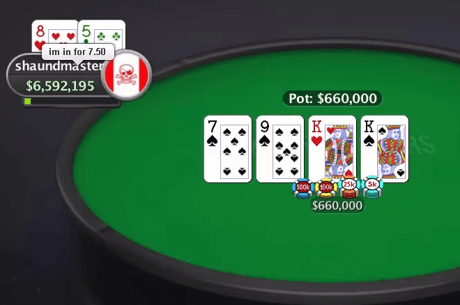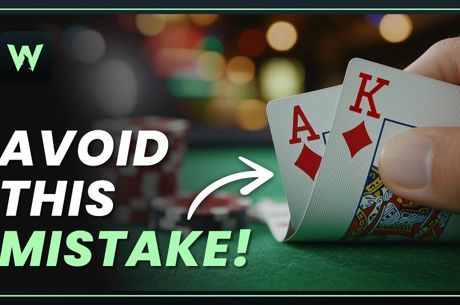5 Live Poker Tips to Help You Win More Cash

Table Of Contents
Live poker games are quite lucrative, but you’ll need to get a good handle on the nuances of live poker if you want to win big.
Here are 5 live poker tips, including 2 video tips from Doug Polk and Ryan Fee, that will help you crush the game on your next trip to the casino.
Also, make sure to grab the free live poker guide at the end.
Tip 1: Punish Limpers As Much As Possible
If you’re new to live poker, you’ll probably be astounded by how often players open-limp and limp behind. Most of the time, limping is inadvisable and a weak strategy that stints one’s ability to win the pot whilst giving opponents behind an opportunity to exploit them.
Many live players can’t help it. They’ve come to the casino to gamble and want to see tons of flops with tons of hands. They didn’t come to fold!
There are two acceptable approaches when facing a single open-limper:
The Theoretical Approach: Tighten your raising range vs a limper to account for the extra player in the pot.
The more players are in a pot, the less equity a given hand will have (see: multiway pots article). For this reason, it makes sense theoretically to tighten your raise range to account for that drop in equity.
This option is usually better against good players and completely unknown players. Most limpers in live games are weak players, however, and against them it’s best to take a more practical approach.
The Practical Approach: Play looser to isolate the weak player who limped.
Most open-limpers are not good players and will rarely put you in a tough spot. You can actually raise a bit wider to isolate them so they have the chance to make a big mistake against you postflop.
Facing Multiple Limpers
The best way to respond to multiple limps in front of you is to tighten your raising range and use a larger sizing.
Most live players love to call, and there’s nothing more frustrating than trying to isolate the weakest limper only to have every other limper come along as well. By using a larger sizing (we recommend 4-5BB plus 1BB for every additional limper), we prevent the players at the table from getting what they want---a cheap flop.
Tip 2: Turn Up Your Aggression on the Button
The power of position is especially advantageous against weaker competition.
Being on the button allows you to make decisions with the maximum possible amount of information, and that’s super helpful versus weak opponents who love calling and betting unconventional sizes.
In preflop spots on the button, you can profitably call small and medium-sized raises with a wide range of hands that can be played easily and effectively postflop (like suited connectors and pairs.)
Also, because aggressive 3-betting does not typically occur in live games, you can call on the button without much fear of facing a squeeze 3-bet from the blinds.
In postflop spots, you will often get a great price to realize your equity. You’ll also get ample opportunities to stab at the pot when your opponents are acting passively.
Playing too passively on the button is a very common mistake among poker players. For more on how to avoid it, check out Ryan’s article 12 Preflop Mistakes You Must Avoid (#5 and #7 are about button play).
Tip 3: Play Faster
Tanking in poker is almost fashionable these days.
Fake tanking can be reasonable in order to balance your response-time and avoid giving off timing tells, but it is completely unnecessary in the vast majority of spots.
Not only do fake tanks frustrate the other players at the table, they also cut into a winning player’s hourly win-rate by reducing their number of hands played per hour. If you’re a good player, you want to see as many hands per hour as possible to maximize your hourly.
In case that wasn’t enough to convince you to speed up, check out guest blogger Jimmy Fricke’s 6 Reasons Why You Need to Play Faster.
Tip 4: Keep an Eye Out for Exploitative Adjustments
I'll let Doug take this one.
Doug: My tip for live poker is to make sure you keep an eye on what your opponents are doing.
Let's say you're playing a game and you see someone check-raise very thin for value, like KT on a K-9-4 type of flop. What I might think to myself after seeing that is:
If they're going to check/raise that thin for value, when they do decide to check/call they are going to have a particularly weak range.
When you're playing against an opponent like this, you're going to want to make a few adjustments:
- Barrel the turn and river more often.
- Go for thinner value bets on later streets.
- Bluff them more often on later streets.
Whenever you get the chance to see your opponents' hands in live games, think about how you would have played the hand and if they made any notable mistakes. Then adjust your strategy to beat them for more money.
Tip 5: Watch Out for this Live Tell
Ryan’s turn.
Ryan: There is one tell in all of poker that I might use, and it's this: when a monotone flop (3 cards of the same suit) is dealt and your opponent takes a look back at their cards, they are likely checking to see if they have a card of that suit.
For instance, you raise on the button and the big blind calls. The flop comes 8♥6♥3♥ and the big blind looks at his cards before checking. The big blind is more than likely trying to see if his hand has a heart in it.
Another spot this tell may happen is on two-tone flops. Imagine you defend your big blind against a UTG raise, the flop comes 10♠9♠4♥, and UTG looks at their cards. It's possible they have a hand like AK offsuit, and they're checking to see which card is a spade or if they have a spade at all.
As with all tells, you should be very selective when trying to apply this tell in game. It's usually not the best idea to make hero folds or hero calls based on a live tell. However, using them in close spots to sway your decision one way or the other is fine.
Get the 10 Laws of Live Poker for More Live Wisdom
Our team of poker pros put together this free guide that will level-up your live poker strategy and mental game.
Flipping through it will only take you a few minutes and your bankroll will thank you. Get the 10 Laws of Live Poker now!
Sponsor generated content by Upswing Poker written by Mike Brady.








